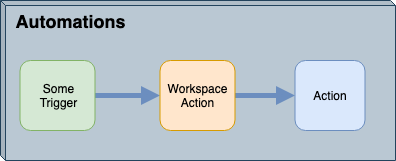Workspaces as a 'Trigger'
Workspaces and other Internal Actions are the only protocols that have both input and output ports. This means that although they are treated as an Action, since they need something to kick them off, they can also act as a trigger to subsequent actions downstream an Automation.
Notifications from the Workspace are important for both sending messages containing content from the data being processed, and for reporting the status of a translation, such as whether it ran successfully or ended in failure.
In an Automation workspace nodes have two outports representing the workspace status. One for Success and the other for Failure, this allows you to build an action in response to one or both job statuses.
Alternatively, Workspaces can be set up to trigger FME Server Topics to be used in an Automation. This is handy if the workspace does not have a regular trigger, or is run from a process other than a listed protocol e.g. via an FME Server App, however you still want there to be an external response to the workspace. A workspace can be registered to notify a topic in one of two ways:
- Registering with the topic when it is published
- Using a transformer inside the workspace
A Topic is a component on FME Server that acts as a mediator for messages and defines the message content. Think of it as a mix of the subject line for notifications and a trigger for them to occur. You can create a Topic trigger in the FME Server web user interface through Automations.
A Workspace can be linked to multiple topics, so each incoming message can trigger multiple actions to occur. Additionally, multiple workspaces can link to a single topic.
| TIP |
|
Posting a message to a topic is not restricted to FME Workspaces only. When a topic is created a POST URL is generated. This can be set up as a webhook in third party software to post a message to the FME Server topic in response to an action on that application. These URLs can be found under the Advanced section of the Topic under Notifications > Topics. |

